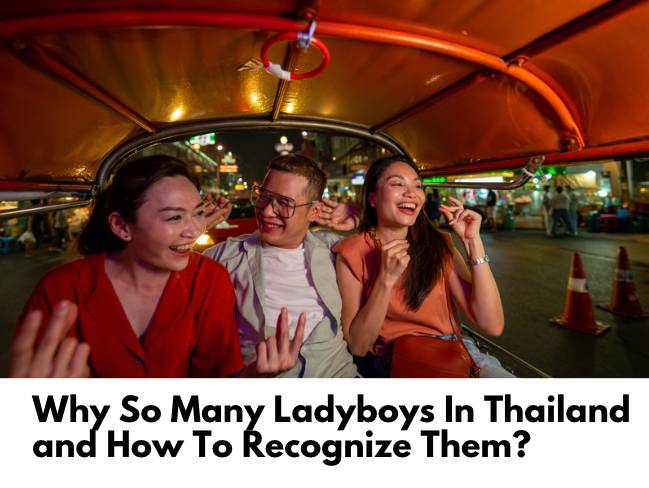Thailand is often one of the first countries that comes to mind when we think of somewhere exotic to visit. With its interesting people, stunning landscapes, ancient temples, and excellent street food, it has something to offer every potential tourist.
Another interesting aspect of the country, and one that many tourists specifically seek out, is its population of openly gay or transgender “ladyboys.”
Whether people go there to see them, meet them, or even have sex with them, these fascinating people have become a large part of Thailand’s culture. But what are they, exactly?
What are Ladyboys?
Firstly, the term “ladyboys” is considered and used as a derogatory word by many Westerners, and although most Thai people are not offended by it, it might be safer to just call them women (phuying) if you decide to visit Thailand and meet these interesting people. Or you could just ask them what they prefer to be called.
Traditionally, ladyboys were not seen as women in men’s bodies or just gay, but rather as a third gender that was created when 2 souls were born into a single body. This gender is called kathoey in Thailand.
In reality, they are usually people born into male bodies who would prefer to be women, and many of them go through gender-affirming surgery, better known as a sex change, to become women. Those who don’t are often just gay men who prefer to dress in a feminine way.
Many transgender people feel that they were born into the wrong body – like their soul is female, for example, and they are born into a male body. This is a common occurrence all around the world, not just in Thailand, so why does it seem to be more prevalent there?
Why Are There So Many Ladyboys in Thailand?
There have been numerous studies done based on people’s assumptions about the population of transgender women in Thailand, but none of them has provided any concrete evidence that there is a reason for them being more prevalent there than anywhere else.
Some people believe that there are social and scientific reasons for men in Thailand to be more feminine, and the theories range from possible to ridiculous. Here are some of the more ridiculous ones:
- A few people think that children who are raised solely by women will grow up more feminine.
- Many people believe that hormones in the local food create an estrogen effect in the body, turning boys more feminine.
- Some bigoted people think that gender dysphoria is a mental illness caused by hormonal problems, and that the hormones are secretly being fed to these children.
- Some believe that these people choose to be transgender on purpose because they can make money from it.
No study that has been run so far can back up any of these statements or theories, and chances are, the prevalence of ladyboys in Thailand is entirely due to social constructs and societal norms.
In other words, if there is any reason for there being more openly transgender women or gay men in Thailand than anywhere else, it is likely because they are more accepted by society than in many other countries.
To compare, as much as 4% of Thailand’s population is openly transgender, while only 0.5% of North America’s population has admitted to being uncomfortable with the sex assigned to them at birth.
This doesn’t necessarily mean that Thailand has more transgender people by population – just that it is easier to be gay or transgender there than it is in the USA. Also, because it is mostly accepted in Thailand, it has become an industry or tourist attraction, meaning that it is more obvious and has a more established population.
Another reason why there may be more transgender women in Thailand is because of the ease of access to gender-reassignment surgery. In many countries, it is illegal to have a sex change or even dress as the opposite gender, but in Thailand, gender-affirming surgery is not just legal, but common, with approximately 3 surgeries being performed each week.
It is so easily available and affordable that people from all over the world travel to Thailand for their gender reassignments. But just because it’s easily available doesn’t mean it’s easy.
People opting for a sex change in Thailand have to jump through some serious hoops to prove that they do suffer from gender dysphoria, and there are some strict protocols they have to follow before the operation, including taking hormone treatments for a year.
How to Recognize Ladyboys

There are a few ways you can try to tell the difference between a ladyboy and a cisgender female, and I will list them below, but the easiest way is probably just to ask!
- Height – transgender women or transvestite men will often be taller than the local cisgender women.
- Male features – kathoey will generally have more masculine bodies, including broad shoulders and narrow hips, and have stronger facial features and jawlines.
- Hands and feet – transgender or transvestite women will generally have larger hands and feet than cis females.
- Adam’s apple – an Adam’s apple is a good way to tell if someone was born male, since women aren’t born with them. Not all males have them either though, so this isn’t the most helpful suggestion.
- Voice – unless a transgender woman has undergone gender reassignment and hormone therapy, her voice will most likely still be quite masculine.
- Clothing and makeup – many ladyboys will dress in bright colors and flamboyant styles generally not adopted by cis women.
- The bulges – trans women who have had breast implants will usually have larger breasts than the local women naturally have, and those who have not yet undergone gender-affirming surgery will probably still have some level of bulge in the crotch area, even if they tuck it away.
Always remember that none of these is a surefire way to know whether someone is a ladyboy or a cis female.
Why Are Transgender People More Accepted in Thailand?
There is a common misconception, especially amongst anti-trans populations, that being transgender is a new thing. But the truth is that transgenderism has been around for all of recorded history, with evidence of it going back at least 5000 years.
Thailand is just more accepting of it than many other places, generally allowing people to go about their lives without judgment, despite how different they are from each other. There are a number of reasons for this:
Buddhism
Some of this may be due to the most popular local religion – Buddhism. Although transgenderism and homosexuality are not accepted or encouraged in Buddhism, neither is sex in general.
You could say that sex itself is considered a sin, rather than who you copulate with. Buddhism is a rather forgiving religion, and things like homosexuality are explained away by religious dogma, rather than being prohibited or frowned upon.
For example, some Buddhists believe that people are transgender because they were the opposite sex in a previous life and they haven’t let go, while others believe it is a punishment for sins committed in a previous life.
Either way, they overlook it as something that cannot be solved or changed in that particular lifetime, which is better than the reactions of certain other religions that try to “correct” the behavior with prayer, “tough love,” rape, or even torture.
History
In Thailand’s history, kathoey people have taken on many important roles in society. They have been actors, religious icons, musicians, politicians, and sports stars, as well as entertainers in the Royal Court. As a result, they have been seen and acknowledged for decades.
Entertainment
The appearance of ladyboys in the entertainment industry is not only relegated to history – in fact, they are even more common now. Although they are still found in the music and film industries, and in sports, their roles in entertainment are more commonly for tourism these days.
Kathoey are often performers in cabarets and other theater shows, and this, along with their history in Thailand, has given them the exposure they needed to become an accepted part of society.
Economy
Despite all of this, life for the ladyboys of Thailand is not as easy as it sounds. It is certainly easier than it is for transgender women in many other Asian countries, but there is still a stigma that they deal with on a regular basis.
Many unaccepting Thai people believe that there is something wrong with trans people, such as a mental illness. This could stem from the Buddhist belief that they are paying for their sins from a past life, or it could just be bigotry and homophobia.
Either way, many ladyboys choose to go into the sex and entertainment industries because they are more accepted there than in the general economy of the country, and they don’t face the same discrimination. All the better for those of us who would like to visit the country and meet them!
Legality
The Gender Equality Act of 2015 is meant to prevent Thai citizens from discriminating against trans people based on their sexuality, and it is a positive step that the government has taken towards real equality.
However, it will still be some time before the ladyboys of Thailand are truly accepted by all their neighbors, especially if the government doesn’t make a point of enforcing this law.
Are All LGBTQ+ People Accepted in Thailand?
Interestingly, transgender women are more accepted in Thailand than gay men, which is perhaps the opposite of how things are in most Western societies. Although homosexual people still face plenty of discrimination in the Western world, they appear slightly more “normal” to the average bigot than transgender people.
The opposite is true in Thailand because of the roles transgender people have historically taken, making them appear more “normal” than gay men. As a result, men who prefer to have sex with other men are less accepted than birth-assigned males who choose to live as or become females or kathoey.
Even in lesbian relationships, it is uncommon in Thailand for 2 masculine-looking women to be seen together, and the same can be said for 2 feminine women. Usually, lesbian couples will consist of a feminine girl and a tom-boy. Perhaps the societal pressures in Thailand are more intense than they appear from the outside.
It’s also interesting to note that despite the acceptance of transgender people in Thailand, they are not legally allowed to change their gender. This means that a trans person’s ID or passport will still state them as their birth sex, which could cause some confusion if they choose to travel.
Also, same-sex marriage or civil union is not yet legal in Thailand, and same-sex couples are not allowed to adopt children – that right is reserved for heterosexual couples and single women.
So despite Thailand’s claims that they are a “gay-friendly” country, they do not yet treat their own gay people as first-class citizens. It is more of a tourism draw than a real way of life there.
How is Sex Work Viewed in Thailand?
Despite some of Thailand’s old-fashioned rules, sex work is rampant there. That doesn’t mean it’s legal, and sex workers run the risk of having to pay large fines or spend years in prison if they get caught. They are also not afforded basic labor or legal rights.
However, sex work is one of Thailand’s big earners, with tourists coming from all over to “try out” the famous ladyboys. Although the government has not amended the laws around sex work, it seems they would rather quietly overlook the activity that brings so much to the local economy.
Conclusion
Thailand’s ladyboys are gay men or transgender women who dress as women and are often found in the sex work or entertainment industries. They are also known as kathoey, or “third gender,” and are famous all over the world.
Many tourists go to Thailand with the specific desire of meeting them, seeing them perform in theater shows, or even having sex with them.
There may not be any more transgender women by population in Thailand than in any other country, but it appears that way because they are more socially accepted there.
As a result, ladyboys have taken roles, both historically and currently, in sports, politics, religion, and entertainment, making themselves known and seen. In other countries where it is less acceptable, a large portion of the transgender population is in hiding. Ease of access to gender-affirming surgery also plays a role.
You can recognize ladyboys by looking for masculine features, such as Adam’s apples, broad shoulders, narrow hips, and strong jawlines, or by looking at their clothing – ladyboys tend to dress more flamboyantly than cis females – breasts, or crotch bulges. However, the easiest way to find out if someone is a ladyboy is to just ask.
Thailand claims to be a gay-friendly country, yet its own gay and trans people are not treated as first-rate citizens. Same-sex marriage is not yet legal and same-sex couples can not adopt children. I hope that this changes very soon so that Thailand’s apparent equality can become a reality.




